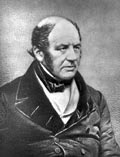Samuel A. Cartwright facts for kids
Quick facts for kids
Samuel A. Cartwright
|
|
|---|---|

Samuel Cartwright
|
|
| Born |
Samuel Adolphus Cartwright
November 3, 1793 |
| Died | May 2, 1863 (aged 69) |
| Nationality | American |
| Education | University of Pennsylvania School of Medicine |
| Occupation | Physician |
| Known for | Coining "drapetomania" |
| Spouse(s) | Mary Wren |
Samuel Adolphus Cartwright (born November 3, 1793 – died May 2, 1863) was an American doctor. He worked in Mississippi and Louisiana before the American Civil War. Cartwright is mostly known for creating the idea of "drapetomania." He claimed this was a mental illness that made enslaved people want to be free. He also strongly disagreed with the idea that tiny germs cause diseases.
Contents
About Samuel Cartwright
Samuel Cartwright married Mary Wren in 1825. She was from Natchez, Mississippi. During the American Civil War, Cartwright worked as a doctor for the Confederate States Army. He helped improve health conditions for soldiers in camps near Vicksburg and Port Hudson.
His Ideas on Slavery
The Medical Association of Louisiana asked Cartwright to study "diseases and physical traits of the Black race." He gave a speech about his findings in 1851. Parts of his report, especially about "drapetomania" and "dysaesthesia aethiopica," were published in a journal called DeBow's Review.
What Was Drapetomania?
Cartwright invented the idea of "drapetomania." He claimed it was a mental illness that caused enslaved people to want to run away and be free. He believed that if enslaved people became unhappy, they should be punished to stop them from trying to escape. Cartwright used parts of the Bible to support his ideas about this made-up condition. It is important to know that "drapetomania" was not a real illness.
What Was Dysaesthesia Aethiopica?
Cartwright also created another made-up "disorder" called dysaesthesia aethiopica. He said this disease affected both the mind and body. Cartwright used this idea to explain why some enslaved people might not work as hard. He claimed this "illness" made people's skin less sensitive. It also made them feel very sleepy or confused, "like a person half asleep." He said there were also "lesions of the body" that doctors could see.
Cartwright believed that dysaesthesia aethiopica was more common among free Black people. He claimed it affected "nearly all" free Black people who did not have a white person to guide them. These ideas were not based on real science or medicine.
In Movies and Culture
Cartwright in Films
- Cartwright was mentioned in the 2004 movie C.S.A.: The Confederate States of America. In this film, the Confederate States of America wins the Civil War. Cartwright's ideas then become the basis for a fictional school. This school is called the Cartwright Institute for Freedom Illnesses. It teaches his theories about "drapetomania" and other "peculiarities" of Black people.
- Cartwright is also shown in the 1971 movie Goodbye Uncle Tom. In this film, he is incorrectly shown as being Jewish.
See also
 In Spanish: Samuel A. Cartwright para niños
In Spanish: Samuel A. Cartwright para niños

